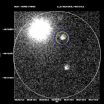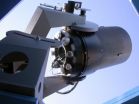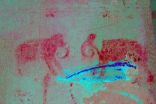(Press-News.org) Intense light from the enormous explosion of a star more than 12 billion years ago — shortly after the Big Bang — recently reached Earth and was visible in the sky.
Known as a gamma-ray burst, light from the rare, high-energy explosion traveled for 12.1 billion years before it was detected and observed by a telescope owned by Southern Methodist University, Dallas.
Gamma-ray bursts are believed to be the catastrophic collapse of a star at the end of its life. SMU physicists report that their telescope was the first on the ground to observe the burst and to capture an image, said Farley Ferrante, a graduate student in SMU's Department of Physics, who monitored the observations along with two astronomers in Turkey and Hawaii.
Recorded as GRB 140419A by NASA's Gamma-ray Coordinates Network, the burst was spotted at 11 p.m. April 19 by SMU's robotic telescope, ROTSE-IIIB, at the McDonald Observatory in the Davis Mountains of West Texas.
Gamma-ray bursts are not well understood by astronomers, but they are considered important, Ferrante said.
"As NASA points out, gamma-ray bursts are the most powerful explosions in the universe since the Big Bang," he said. "These bursts release more energy in 10 seconds than our Earth's sun during its entire expected lifespan of 10 billion years."
Some of these gamma-ray bursts appear to be related to supernovae, and correspond to the end-of-life of a massive star, said Robert Kehoe, physics professor and leader of the SMU astronomy team.
"Gamma-ray bursts may be particularly massive cousins to supernovae, or may correspond to cases in which the explosion ejecta are more beamed in our direction. By studying them, we learn about supernovae," Kehoe said.
Scientists weren't able to detect optical light from gamma-ray bursts until the late 1990s, when telescope technology improved. Among all lights in the electromagnetic spectrum, gamma rays have the shortest wavelengths and are visible only using special detectors.
Gamma-ray bursts result from hot stars that measure as enormous as 50 solar masses. The explosion occurs when the stars run out of fuel and collapse in on themselves, forming black holes. Outer layers detonate, shooting out material along the rotation axis in powerful, high-energy jets that include gamma radiation. As the gamma radiation declines, the explosion produces an afterglow of visible optical light. The light, in turn, fades very quickly, said Kehoe. Physicists calculate the distance of the explosion based on the shifting wavelength of the light, or redshift.
"The optical light is visible for anywhere from a few seconds to a few hours," Kehoe said. "Sometimes optical telescopes can capture the spectra. This allows us to calculate the redshift of the light, which tells us how fast the light is moving away from us. This is an indirect indication of the distance from us."
To put into context the age of the new gamma-ray burst discoveries, Kehoe and Ferrante point out that the Big Bang occurred 13.81 billion years ago. GRB 140419A is at a red shift of 3.96, Ferrante said.
"That means that GRB 140419A exploded about 12.1 billion years ago," he said, "which is only about one and a half billion years after the universe began. That is really old."
Armed with images of the burst, astronomers can analyze the observational data to draw further conclusions about the structure of the early universe.
"At the time of this gamma-ray burst's explosion, the universe looked vastly different than it does now," Kehoe said. "It was an early stage of galaxy formation. There weren't heavy elements to make Earth-like planets. So this is a glimpse at the early universe. Observing gamma-ray bursts is important for gaining information about the early universe."
GRB 140419A's brightness, measured by its ability to be seen by someone on Earth, was of the 12th magnitude, Kehoe said, indicating it was only 10 times dimmer than what is visible through binoculars, and only 200 times dimmer than the human eye can see, Kehoe said.
"The difference in brightness is about the same as between the brightest star you can see in the sky, and the dimmest you can see with the naked eye on a clear, dark night," Kehoe said. "Considering this thing was at the edge of the visible universe, that's an extreme explosion. That was something big. Really big."
SMU telescope responded to NASA satellite's detection and notification
SMU's Robotic Optical Transient Search Experiment (ROTSE) IIIb is a robotic telescope. It is part of a network of ground telescopes responsive to a NASA satellite that is central to the space agency's Swift Gamma-Ray Burst Mission. Images of the gamma-ray bursts are at http://bit.ly/1kKZeh5.
When the Swift satellite detects a gamma-ray burst, it instantly relays the location. Telescopes around the world, such as SMU's ROTSE-IIIb, swing into action to observe the burst's afterglow and capture images, said Govinda Dhungana, an SMU graduate student who participated in the gamma-ray burst research.
SMU's ROTSE-IIIb observes optical emission from several gamma-ray bursts each year. It observed GRB 140419A just 55 seconds after the burst was detected by Swift.
Just days later, ROTSE-IIIb observed and reported a second rare and distant gamma-ray burst, GRB 140423A, at 3:30 a.m. April 23. The redshift of that burst corresponds to a look back in time of 11.8 billion years. ROTSE-IIIb observed it 51 seconds after the burst was detected by Swift.
"We have the brightest detection and the earliest response on both of those because our telescope is fully robotic and no human hands were involved," Ferrante said.
Ferrante was first to check observations on GRB 140423A and so is first-author. Tolga Guver, associate professor in the Department of Astronomy and Space Sciences at Istanbul University, Turkey, is second author. On GRB 140419A, Guver is first author and Ferrante is second.
INFORMATION:
The research is funded by the Texas Space Grant Consortium, an affiliate of NASA.
SMUResearch.com on Twitter, http://twitter.com/smuresearch.
For more information, http://www.smuresearch.com.
SMU is a nationally ranked private university in Dallas founded 100 years ago. Today, SMU enrolls nearly 11,000 students who benefit from the academic opportunities and international reach of seven degree-granting schools. For more information see http://www.smu.edu.
SMU has an uplink facility located on campus for live TV, radio, or online interviews. To speak with an SMU expert or book an SMU guest in the studio, call SMU News & Communications at 214-768-7650.
Observed by Texas telescope: Light from huge explosion 12 billion years ago reaches Earth
Known as a gamma-ray burst, the rare, intense light captured in the night sky resulted from one of the biggest and hottest explosions in the universe, occurring shortly after the Big Bang
2014-06-04
ELSE PRESS RELEASES FROM THIS DATE:
A new approach to diversity research
2014-06-04
When people work in socially homogeneous groups, they overestimate their own contributions to the group's success, according to a new study co-authored by an MIT scholar. In fact, in some cases such "self-serving bias" occurs to a degree about five times as great in homogeneous groups as in ethnically diverse groups.
Such results raise a larger point, suggests Evan Apfelbaum, the W. Maurice Young Assistant Professor of Organization Studies at the MIT Sloan School of Management, and the lead author of the new study: Researchers have often used homogeneous social groups ...
NASA should maintain long-term focus on Mars as 'horizon goal' for human spaceflight
2014-06-04
WASHINGTON – Arguing for a continuation of the nation's human space exploration program, a new congressionally mandated report from the National Research Council concludes that the expense of human spaceflight and the dangers to the astronauts involved can be justified only by the goal of putting humans on other worlds. The report recommends that the nation pursue a disciplined "pathway" approach that encompasses executing a specific sequence of intermediate accomplishments and destinations leading to the "horizon goal" of putting humans on Mars. The success of this approach ...
Multilingual or not, infants learn words best when it sounds like home
2014-06-04
Los Angeles, London (June 04, 2014). Growing up in a multilingual home has many advantages, but many parents worry that exposure to multiple languages might delay language acquisition. New research could now lay some of these multilingual myths to rest, thanks to a revealing study that shows both monolingual and bilingual infants learn a new word best from someone with a language background that matches their own.
While 1.5 year old babies are powerful word learners, they can have difficulty learning similar-sounding words (e.g., "coat" and "goat"). A string of previous ...
Shaken, not stirred: Control over complex systems consisting of many quantum particles
2014-06-04
This news release is available in German.
Sometimes quantum particles behave like waves. This phenomenon is often used for high precision measurements, for instance in atomic clocks. Usually, only the wave properties of single particles play a role, but now researchers at the Vienna Center for Quantum Science and Technology, Vienna University of Technology have succeeded in quantum mechanically controlling hundreds of Rubidium atoms of an ultracold Bose-Einstein-condensate by shaking it in just the right way. Now, not only internal states of atoms can be used for ...
Five-question clinical tool the first to help screen risk of violence in military veterans
2014-06-04
CHAPEL HILL, N.C. -- A new brief, 5-question screening tool can help clinicians identify which veterans may be at greater risk of violence, according to a new study led by a UNC researcher.
The study, published online by the American Journal of Psychiatry, is based on a national survey sample of veterans combined with a smaller, in-depth assessment sample. The screening tool, called the Violence Screening and Assessment of Needs (VIO-SCAN), asked veterans about financial stability, combat experience, alcohol misuse, history of violence or arrests, and probable posttraumatic ...
Mayo Clinic moves small-molecule drugs through blood-brain barrier
2014-06-04
ROCHESTER, Minn. — Researchers at Mayo Clinic have demonstrated in a mouse model that their recently developed synthetic peptide carrier is a potential delivery vehicle for brain cancer chemotherapy drugs and other neurological medications. The findings appear in PLOS ONE.
"Not only have we shown that we can transport eight different molecules, we think this method will be less disruptive or invasive because it mimics a normal physiological process," says Mayo Clinic neuroscientist Gobinda Sarkar, Ph.D., the corresponding author of the study. The researchers are able ...
Finding the lost art of Angkor Wat
2014-06-04
Long-lost paintings have been discovered on the walls of Cambodia's ancient Angkor Wat temple, thanks to the keen observations of an Australian National University (ANU) researcher.
The ancient paintings date back almost 500 years and depict deities, animals, boats and the temple itself, giving historians a new understanding of life in a relatively unknown period of Cambodia's history.
Rock art researcher Noel Hidalgo Tan discovered the hidden images while working as a volunteer at an archaeological excavation in Angkor Wat during a university break in 2010.
"I was ...
Four new genes confirmed to increase familial breast cancer risk
2014-06-04
SALT LAKE CITY— Four new genes have been added to the growing list of those known to cause increased breast cancer risk when mutated through the efforts of researchers at Huntsman Cancer Institute (HCI) at the University of Utah, who lead an international consortium working to find more gene mutations that cause inherited breast cancer susceptibilities.
"BRCA1 and BRCA2 aren't the whole story when it comes to inherited breast cancer risk. We've known for a long time that more genes had to be responsible and several have since been discovered, by us and by others," according ...
Preserving bread longer: A new edible film made with essential oils
2014-06-04
Essential oils have boomed in popularity as more people seek out alternatives to replace their synthetic cleaning products, anti-mosquito sprays and medicines. Now scientists are tapping them as candidates to preserve food in a more consumer-friendly way. A study from ACS' Journal of Agricultural and Food Chemistry reports the development of new edible films containing oils from clove and oregano that preserve bread longer than commercial additives.
Nilda de F. F. Soares and colleagues note that the search for new ways to keep packaged food from spoiling has led some ...
Quantum criticality observed in new class of materials
2014-06-04
Quantum criticality, the strange electronic state that may be intimately related to high-temperature superconductivity, is notoriously difficult to study. But a new discovery of "quantum critical points" could allow physicists to develop a classification scheme for quantum criticality -- the first step toward a broader explanation.
Quantum criticality occurs in only a few composite crystalline materials and happens at absolute zero -- the lowest possible temperature in the universe. The paucity of experimental observations of quantum criticality has left theorists wanting ...
LAST 30 PRESS RELEASES:
Interaction of climate change and human activity and its impact on plant diversity in Qinghai-Tibet plateau
From addressing uncertainty to national strategy: an interpretation of Professor Lim Siong Guan’s views
Clinical trials on AI language model use in digestive healthcare
Scientists improve robotic visual–inertial trajectory localization accuracy using cross-modal interaction and selection techniques
Correlation between cancer cachexia and immune-related adverse events in HCC
Human adipose tissue: a new source for functional organoids
Metro lines double as freight highways during off-peak hours, Beijing study shows
Biomedical functions and applications of nanomaterials in tumor diagnosis and treatment: perspectives from ophthalmic oncology
3D imaging unveils how passivation improves perovskite solar cell performance
Enriching framework Al sites in 8-membered rings of Cu-SSZ-39 zeolite to enhance low-temperature ammonia selective catalytic reduction performance
AI-powered RNA drug development: a new frontier in therapeutics
Decoupling the HOR enhancement on PtRu: Dynamically matching interfacial water to reaction coordinates
Sulfur isn’t poisonous when it synergistically acts with phosphine in olefins hydroformylation
URI researchers uncover molecular mechanisms behind speciation in corals
Chitin based carbon aerogel offers a cleaner way to store thermal energy
Tracing hidden sources of nitrate pollution in rapidly changing rural urban landscapes
Viruses on plastic pollution may quietly accelerate the spread of antibiotic resistance
Three UH Rainbow Babies & Children’s faculty elected to prestigious American Pediatric Society
Tunnel resilience models unveiled to aid post-earthquake recovery
Satellite communication systems: the future of 5G/6G connectivity
Space computing power networks: a new frontier for satellite technologies
Experiments advance potential of protein that makes hydrogen sulfide as a therapeutic target for Alzheimer’s disease
Examining private equity’s role in fertility care
Current Molecular Pharmacology achieves a landmark: real-time CiteScore advances to 7.2
Skeletal muscle epigenetic clocks developed using postmortem tissue from an Asian population
Estimating unemployment rates with social media data
Climate policies can backfire by eroding “green” values, study finds
Too much screen time too soon? A*STAR study links infant screen exposure to brain changes and teen anxiety
Global psychiatry mourns Professor Dan Stein, visionary who transformed mental health science across Africa and beyond
KIST develops eco-friendly palladium recovery technology to safeguard resource security
[Press-News.org] Observed by Texas telescope: Light from huge explosion 12 billion years ago reaches EarthKnown as a gamma-ray burst, the rare, intense light captured in the night sky resulted from one of the biggest and hottest explosions in the universe, occurring shortly after the Big Bang




